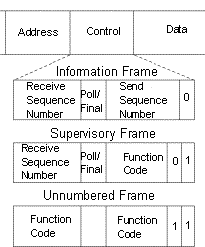HDLC (High-level Data Link Control) is a group of protocols documented in ISO 3309 for transmitting synchronous data between serial links (Point-to-Point nodes). HDLC organizes data into a frame before transmission. HDLC protocol operates within Layer 2 (data link layer) of the OSI model.
HDLC Frame Structure:

The HDLC frame consists of Flag, Address, Control, Data, and CRC fields as shown. The bit length of each field is given below:
Flag (both opening and closing flags): 8 bits (01111110 or 7E hex)
Address: It is normally 8 or 16 bits in length. A leading 'zero' bit (MSB) indicates a unicast message; the remaining bits provide the destination node address. A leading 'one' bit (MSB) location indicates multicast message, the remaining bits provide the group address.
Control: The field is 8 bits, or 16 bits wide and indicates whether the frame is a Control or Data frame. The field contains sequence number (hdlc frames are numbered to ensure delivery), poll (you need to reply) and final (indicating that this is the last frame) bits.
Data (Payload): This is the information that is carried from node to node. This is a variable field. Sometimes padded with extra bits to provide fixed length.
FCS (Frame Check Sequence) or CRC (Cyclic Redundancy Code): It is normally 16 bits wide. Frame Check Sequence is used to verify the data integrity. If the FCS fails, the frame is discarded.
The polynomial used for 16 bit FCS:
FCS [16 bits] = X16 + X12 + X5 + 1
Closing Flag: It is same as Opening Flag.
If no prior care is taken, it is possible that flag character (01111110) is present in data field. If present, then it will wrongly be interpreted as end of frame. To avoid this ambiguity, a transmitter will force a '0' bit after encountering 5 continuous 1s. At the receiving end, the receiver drops the '0' bit when encountered with 5 continuous 1s, and continues with the next bit. This way, the flag pattern (01111110) is avoided in the data field.
Normally, synchronous links transmit all the time. But, useful information may not be present at all times. Idle flags [11111111] may be sent to fill the gap between useful frames. Alternatively, a series of flags [01111110] may be transmitted to fill gaps between frames instead of transmitting idle flags [11111111]. Continuous transmission of signals is required to keep both the transmitting and receiving nodes synchronized.
Ex.: frame...flag...flag...flag...frame..flag..flag..frame...frame...
PPP and SLIP use a subnet of HDLC protocol. ISDN's D channel uses a modified version of HDLC. Also, note that Cisco routers' uses HDLC as default serial link encapsulation protocol.
HDLC Frame Types
The control field in HDLC is also used to indicate the frame type. There are three types of frames supported by HDLC. These are:
I Frames: These are information frames, and contain user data
S Frames: These are supervisory frames, and contain contain commands and responses
U Frames: These are un-numbered frames, and typically contain commands and responses.

I Frames are sequentially numbered, carry user data, poll and final bits, and message acknowledgements.
S Frames performs any retransmission requests, and other supervisory controls.
U Frames can be used to initialize secondaries.
Disclaimer: Simulationexams.com is not affiliated with any certification vendor, and Sim-Ex™ Practice Exams are written independently by SimulationExams.com and not affiliated or authorized by respective certification providers. Sim-Ex™ is a trade mark of SimulationExams.com or entity representing Simulationexams.com.CCNA™ is a trademark of Cisco® systems